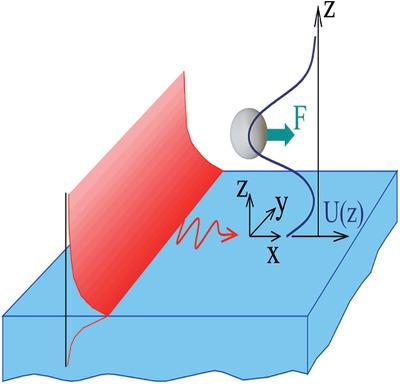当前位置:
X-MOL 学术
›
Ann. Phys. (Berlin)
›
论文详情
Our official English website, www.x-mol.net, welcomes your
feedback! (Note: you will need to create a separate account there.)
Binding of Resonant Dielectric Particles to Metal Surfaces Using Plasmons
Annalen Der Physik ( IF 2.2 ) Pub Date : 2020-05-04 , DOI: 10.1002/andp.202000129 Alexey V. Maslov 1
Annalen Der Physik ( IF 2.2 ) Pub Date : 2020-05-04 , DOI: 10.1002/andp.202000129 Alexey V. Maslov 1
Affiliation

|
Forces between dielectric particles induced by optical fields can bind them into new systems, varying from optical molecules to large aggregates. Here it is shown that surface plasmons can bind resonant dielectric particles to the waveguiding surfaces resulting in stable levitation of the particles by the optical forces alone. At the same time, the particles can be propelled efficiently along the surface. The predictions follow from solving the 3D electromagnetic problem of plasmon scattering on a dielectric microsphere near the metal surface. To tackle the problem, an accurate and fast hybrid approach is developed: the fields are expanded into 2D angular components which are calculated using finite‐difference time‐domain simulations. The rigorous numerical results are also explained qualitatively using an analytically solvable model in which a resonant magnetic dipole illuminated by a plasmon interacts with the surface. The particle binding to surfaces is a remarkable outcome of the strong optical interaction at nanoscale and it may offer new configurations for particle manipulations by guided waves, especially in chip‐scale structures.
中文翻译:

使用等离振子将共振介电粒子结合到金属表面
由光场引起的介电粒子之间的力可以将它们结合到新系统中,从光学分子到大型聚集体不等。在此表明,表面等离子体激元可以将共振的介电粒子结合到波导表面,从而仅靠光学力就能稳定地悬浮粒子。同时,颗粒可以沿着表面有效地推进。这些预测来自解决金属表面附近的电介质微球上的等离激元散射的3D电磁问题。为了解决该问题,开发了一种精确而快速的混合方法:将场扩展为二维角分量,该分量使用有限差分时域仿真来计算。还使用解析可解模型定性地解释了严格的数值结果,在该模型中,由等离子体激元照射的共振磁偶极子与表面相互作用。粒子与表面的结合是纳米级强光学相互作用的显着结果,它可能为通过导波的粒子操作提供新的配置,尤其是在芯片级结构中。
更新日期:2020-05-04
中文翻译:

使用等离振子将共振介电粒子结合到金属表面
由光场引起的介电粒子之间的力可以将它们结合到新系统中,从光学分子到大型聚集体不等。在此表明,表面等离子体激元可以将共振的介电粒子结合到波导表面,从而仅靠光学力就能稳定地悬浮粒子。同时,颗粒可以沿着表面有效地推进。这些预测来自解决金属表面附近的电介质微球上的等离激元散射的3D电磁问题。为了解决该问题,开发了一种精确而快速的混合方法:将场扩展为二维角分量,该分量使用有限差分时域仿真来计算。还使用解析可解模型定性地解释了严格的数值结果,在该模型中,由等离子体激元照射的共振磁偶极子与表面相互作用。粒子与表面的结合是纳米级强光学相互作用的显着结果,它可能为通过导波的粒子操作提供新的配置,尤其是在芯片级结构中。











































 京公网安备 11010802027423号
京公网安备 11010802027423号